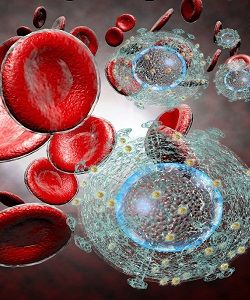HPV Vaccine Compatible with Prevalent Types Found in HIV-Positive Men
HIV-positive men who have sex with men or women are at risk for HPV.

Anal human papillomavirus infection (HPV) is prevalent in men with HIV. While there are HPV vaccines available, it’s not totally clear if the HPV types most commonly found in HIV-infected men are covered by those vaccines.
Pragna Patel, MD, MPH, of the Centers for Disease Control and Prevention (CDC), and colleagues set out to uncover prominent types of HPV in both men who have sex (MSM) with men and men who have sex with women (MSW). Their findings were presented at the Conference on Retroviruses and Opportunistic Infections (CROI 2017) in Seattle, Washington.
Most squamous cell anal cancers have been linked to HPV, which is a group of over 150 related viruses. The American Cancer Society identified HPV-16 as being the most likely to cause anal cancer. HPV-18, HPV-31, HPV-33, and HPV-45 are also strongly connected to cancer.
The nonavalent (9V) vaccine covers seven high-risk types of HPV—16, 18, 31, 33, 45, 52, and 58. Patel and team compared these types with the ones found in the HIV-positive men.
The cohort was made up of 403 MSM and 96 MSW with a median age of 42. Baseline characteristics were similar between the groups: prescribed antiretroviral therapy (ART) (78% vs. 81%), median CD4 cell count (454 cells/mm³ and 379 cells/mm³), CD4 counts > 200 cells/mm³ (90% and 83%), and undetectable viral load (74% and 75%), respectively. The Study to Understand the Natural History of HIV/AIDS in the Era of Effective Therapy (known as the SUN Study) participants came from seven clinics in Minneapolis, Minnesota; Denver, Colorado; St. Louis, Missouri; and Providence, Rhode Island.
From March 1, 2004 to June 30, 2006, the researchers collected anal swabs from study participants. Follow-up occurred every six months until June 1, 2012. They found that 74% of MSM and 32% MSW had any 9v high risk HPV type. Of those participants, 63% and 44% in each group had abnormal anal cytology.
In addition, demographic and sexual behavior data were gathered using an audio computer-assisted self-interview.

“Among MSM and MSW, clearance of any 9v high risk types was similar to any non-9v high risk types (43 vs. 55, P = .143 and 67 vs. 74, P = .872, respectively),” the team reported. Both groups also had similar incidence of any high risk 9v type.
HPV-16 was the most prevalent type found in both MSM and MSW. However, it was more prevalent and had a higher incidence rate in MSM compared to MSW (38% vs. 14% and 4.6% and 1.7%, respectively). Other prevalent types found in MSM and MSW participants included: HPV-6 (25% vs. 11%), HPV-18 (24% vs. 8%), and HPV-45 (24% vs. 7%).
A decrease in 9v and non-9v HPV types was observed in both groups from baseline to 2012.
Of the 368 MSM who had adequate anal cytology, 206 (56%) had abnormal anal cytology which correlated with any 9v high risk HPV. The same could be said about 17 out of 87 MSW who had adequate anal cytology.
Overall, there were more 9v than non-9v HPV types found among the participants. However, the researchers said that the prevalence of non-9v HPV types identified was substantial.
“In this contemporary cohort of HIV-infected men, the prevalence of seven high risk HPV types in the nonavalent vaccine was high and correlated with the presence of cytologic abnormalities,” the researchers concluded.
The team suggested that MSW with HIV could benefit from initial screening and the 9v HPV vaccine could help prevention.